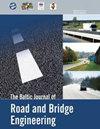立陶宛产钢纤维增强混凝土梁开裂性能试验研究
IF 1.1
4区 工程技术
Q4 ENGINEERING, CIVIL
引用次数: 7
摘要
混凝土是立陶宛使用最广泛的桥梁结构材料。作者进行的一项案例研究表明,纤维的应用可能会提高此类结构的可用性。然而,对钢纤维混凝土开裂后性能的预测可能不够充分。后一个问题与钢纤维混凝土残余强度的评估密切相关。在大多数情况下,残余强度被认为是开裂混凝土的一种材料特性。然而,在预测钢筋混凝土构件的结构性能时,直接应用通过使用标准技术评估的残余强度值可能会导致错误的结果。本研究涉及由立陶宛公司提供的骨料和纤维混凝土制成的结构元件的后开裂行为。介绍了三根全尺寸和十六根标准钢纤维混凝土梁的试验结果,这些梁具有两种不同的纤维含量(23.6kg/m3和47.1kg/m3)。全尺寸的梁用高级钢筋加固。通过实验揭示了纤维最小含量与钢筋结合应用的有效性。本文章由计算机程序翻译,如有差异,请以英文原文为准。
Experimental Investigation of Cracking Behaviour of Concrete Beams Reinforced with Steel Fibres Produced in Lithuania
Concrete is the most widely used material for bridge structures in Lithuania. A case study performed by the authors revealed that application of fibres might improve serviceability of such structures. However, adequacy of prediction of the post-cracking behaviour of steel fibre reinforced concrete might be insufficient. The latter issue is closely related to the assessment of the residual strength of steel fibre reinforced concrete. The residual strength, in most cases, is considered as a material property of the cracked concrete. However, in the prediction of the structural behaviour of the concrete members with bar reinforcement, a straightforward application of the residual strength values assessed by using standard techniques might lead to incorrect results. The present study deals with the post-cracking behaviour of structural elements made of concrete with aggregates and fibres provided by Lithuanian companies. Test results of three full-scale and sixteen standard steel fibre reinforced concrete beams with two different content of fibres (23.6 kg/m3 and 47.1 kg/m3) are presented. The full-scale beams were reinforced with high-grade steel bars. Effectiveness of the application of the mini- mum content of the fibres in combination with bar reinforcement was revealed experimentally.
求助全文
通过发布文献求助,成功后即可免费获取论文全文。
去求助
来源期刊
CiteScore
2.10
自引率
9.10%
发文量
25
审稿时长
>12 weeks
期刊介绍:
THE JOURNAL IS DESIGNED FOR PUBLISHING PAPERS CONCERNING THE FOLLOWING AREAS OF RESEARCH:
road and bridge research and design,
road construction materials and technologies,
bridge construction materials and technologies,
road and bridge repair,
road and bridge maintenance,
traffic safety,
road and bridge information technologies,
environmental issues,
road climatology,
low-volume roads,
normative documentation,
quality management and assurance,
road infrastructure and its assessment,
asset management,
road and bridge construction financing,
specialist pre-service and in-service training;

 求助内容:
求助内容: 应助结果提醒方式:
应助结果提醒方式:


